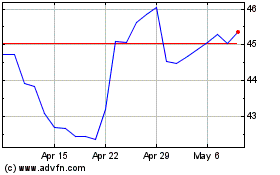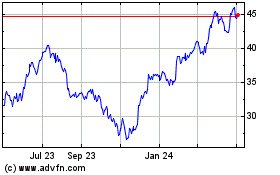By Nora Naughton
This article is being republished as part of our daily
reproduction of WSJ.com articles that also appeared in the U.S.
print edition of The Wall Street Journal (October 26, 2019).
After 40 days of picketing, the United Auto Workers union is
ending its nationwide strike at General Motors Co.
The UAW said Friday it has secured a new labor deal with GM,
resolving one of the nation's longest private-sector walkouts in
years and allowing the Detroit car company to restart its U.S.
factories.
GM workers voted 57% in favor of approving the new four-year
agreement, which includes better wages, hefty signing bonuses and a
commitment from GM to invest $7.7 billion in its U.S. manufacturing
operations, securing 9,000 jobs.
The new labor accord, covering more than 46,000 blue-collar
workers, will allow GM to move forward with closing three U.S.
factories, including a massive assembly plant in Lordstown, Ohio.
Workers will return to work immediately, and GM plans to resume
production as soon as possible at more than 30 U.S. factories that
have sat idle for six weeks, a company spokesman said.
The car company will schedule overtime to make up for lost
production, giving workers who have been without a paycheck for six
weeks a way to recoup their finances.
Among the auto maker's first priorities is to fill back-ordered
parts at dealerships, which have had to delay repairs. GM plans to
have its plants running full-tilt again early next week, the
spokesman said.
The new contract represents a victory for UAW President Gary
Jones, who will next turn the union's attention to contract talks
at Ford Motor Co. UAW negotiators will use the GM agreement as a
template for reaching similar deals with the other two U.S. car
companies, a tactic typical in pattern bargaining.
The strike, the company's longest nationwide walkout in nearly a
half century, crippled GM's U.S. manufacturing operations and
rippled through the broader economy, resulting in temporary layoffs
for thousands of non-UAW workers. The financial toll on GM and the
Midwest economy will continue to linger well after the strike
ends.
Analysts estimate the disruption to GM's U.S. factories, as well
as those in Mexico and Canada that were idled because of parts
shortages, has cost GM roughly 300,000 units of lost vehicle
production that it will now have to make up.
The damage to GM's bottom line is likely to exceed $3 billion
with most of the hit to be reported in the fourth quarter,
according to Bank of America. On top of that, the new union
agreement is expected to tack on $100 million or more a year in
higher labor costs, industry analysts estimate.
The strike's impact also cut deep for GM's auto-parts suppliers.
Many were forced to idle their own plants and temporarily lay off
workers. For some, such as Magna International Inc. and Lear Corp.,
the work stoppage could shave more than 3% from their 2019
earnings, according to analysts at Citigroup Inc.
GM workers won some considerable gains in this latest round of
bargaining, including better pay for new hires, a path to full-time
status for temps and no changes to the employee health-care
contribution, currently at 3% and far lower than the average for
other private-sector workers. They also will receive a one-time
$11,000 bonuses for ratifying the contract.
Still, some UAW members had reservations, expecting more after
spending six weeks on strike without a company paycheck.
Aaron Fowlkes, a production worker at GM's Orion Township,
Mich., assembly plant, said he isn't totally sold on the new
contract, mostly because he doesn't feel it goes far enough on job
security, but voted yes anyway. "If we send it back, what's our end
game?" he said. "I don't know if there's anything else we can ask
for that is feasible."
Some of the gains achieved by the UAW at GM will be a harder
sell at Ford and Fiat Chrysler, which aren't as strong financially
and have different workforce needs, labor experts say.
With 56,000 UAW-represented employees, Ford's hourly workforce
is much larger than GM's, and it is confronting a fast-rising
health-care tab that is expected to exceed $1 billion annually next
year.
Fiat Chrysler is likely to have more trouble absorbing costs
associated with the changes on temporary workers and new-hire pay,
mostly because it has a relatively newer workforce, with many
members still not earning the top wage. The company has about
47,200 UAW-represented workers, and about half of those working in
manufacturing earn less than full pay of nearly $30 an hour.
"This pattern is pretty costly because one of the big things GM
won is closing plants that will save billions," said Kristin
Dziczek, an economist and labor expert at the Center for Automotive
Research in Ann Arbor, Mich. "The other two don't want to close
plants. If you don't want to close plants, what is the win for the
company?"
(END) Dow Jones Newswires
October 26, 2019 02:47 ET (06:47 GMT)
Copyright (c) 2019 Dow Jones & Company, Inc.
General Motors (NYSE:GM)
Historical Stock Chart
From Mar 2024 to Apr 2024

General Motors (NYSE:GM)
Historical Stock Chart
From Apr 2023 to Apr 2024
